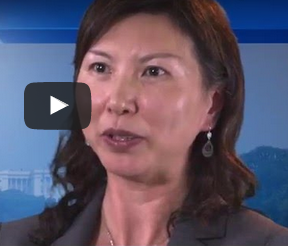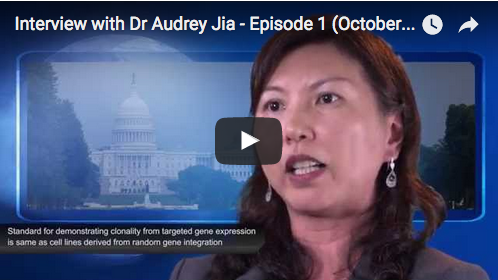
Synopsis: An Interview with Audrey Jia, former FDA CMC Reviewer for Biological Products
Guest Blog by Andrea Gough, Product Manager, Solentim
In a two-part series of interviews commissioned by Solentim, Dr Audrey Jia; a former USFDA CMC Reviewer for Biological Products, was questioned on the key topic of regulatory compliance for the determination of clonality in cell lines producing therapeutic proteins.
The intention of the interviews was to gain some objective, independent advice from an industry expert to assist the cell line development (CLD) community in their quest for further information on BLA/IND submission requirements.
The overarching themes discussed in the interviews and outlined in this summary, focused on the specifics of the regulatory compliance, advice given on CLD best practices and the importance and utility of dedicated imaging systems in cell line development. It is hoped that this advice should also provide some clarity on the information needed in the submission of a successful BLA/IND process.
Both of these interviews are now available for viewing on the Solentim web site – http://www.solentim.com/resources/
Regulatory Compliance
Several questions are put forward to Audrey with regard to the FDA’s stance on clonality, probability and different technologies used in cell line development for producing a clonally derived cell line.
Audrey outlined that the FDA sees clonality as one of the most critical steps in ensuring product quality and safety. The FDA does not currently stipulate, require or recommended specific cloning methods. Nor do they publish a target probability percentage of clonality that is guaranteed to be accepted.
A question often asked by the CLD community surrounds optimal seeding densities. Audrey suggested that the optimal seeding density for limiting dilution really depends upon the user and the plating density they can achieve whilst maintaining a good level of clonality probability.
With regard to an acceptable probability, Audrey references the paper from 1986 by Coller and Coller on limiting dilution at different plating density and she suggests that if a two rounds of limiting dilution at a particular seeding density were deemed acceptable in the past, we can assume that a percentage probability equal to or greater than that would likely be deemed acceptable.
In a previous presentation given by an FDA representative, Sarah Kennett, it was mentioned that advanced cell imaging systems would enable the use of a single round of limiting dilution or single FACS cell sorting, providing an appropriate seeding density was used; this puts a specific requirement on the cell imaging system and its ability to capture an image of the single cell on day 0.
Whilst the FDA see the traditional seeding method of limiting dilution frequently in submissions, they recognize and encourage the use of novel technologies (such as FACS, ClonePix and cell imaging systems) as long as any method used is qualified to ensure it is fit for purpose and evidence of this (qualification data with statistical analysis) is provided as part of the dossier submitted to the FDA.
In the specific case of ClonePix technology, Sarah Kennett presented data which indicated that one round of ClonePix picking from semi-solid media can only give 58~87% probability of clonality, which was deemed unacceptable to the FDA. Due to this, the user would either be required to improve their ClonePix method to show that they can get achieve higher probabilities of picking clonally-derived colonies or perhaps complete an additional round of sub-cloning combined with an appropriate cell imaging system.
CLD Best Practices
Under the remit of CLD best Practices, topics including validity of clonality, targeted genetic integration and clonality of legacy cell lines is discussed.
Audrey confirms in the interview that it is well known that even when starting with a single cell, the resulting population will often result in heterogeneous properties. However, in her opinion, this makes controlling the clonality at the beginning of cell line development even more important because we cannot rely upon the released product based on its profile.
Targeted gene integration is very good technology to generate stable cell line that has the potential for greater stability and higher yield, however, that does not automatically infer clonality. Whether random or targeted integration was used in the CLD process, clonality assurance would still be required.
Audrey suggests that for companies with legacy products under submission, should they encounter a manufacturing change or clonality issue that could impact the post-changed product, a meeting can be set up between the company and the FDA to discuss the path forward. As most legacy products are generated from several round of limiting dilution it is most likely that these products have the quality and safety levels desired.
Importance and Utility of Cell Imagers
Finally, the importance of cell imagers is discussed and what aspects should be considered when using an imager for use in verifying clonality.
During the interview Audrey affirms that a well-designed imaging tool will be very helpful in verifying the single cell status. She goes on to suggest that a good cell imaging tool would allow for a single round of cloning to ensure high clonality and she further specifically proposes a method which she believes users should follow to qualify the combination of limiting dilution and cell imaging system.
When it comes to regulatory requirements of a cell imaging system, Audrey did not reference any regulatory stipulation being in place, however, she believes that the use of the system should be validated and factors such as distinguishing cells from debris, being able to visualize the cells on the edge of the well and being able to capture the single cell in the context of “the whole well” are all important aspects to consider. Also there is no specific guidance on how frequently a well should be imaged; this will depend on cell doubling time and the need to quality the imaging method. Once the method is qualified, the time points of imaging could be defined by the user and cloning needs.
Audrey outlines that during method qualification it may be useful to use fluorescence labeling, however, in regular day to day use, she only believes bright field illumination is necessary in order to achieve image capture for single cell cloning purposes. Audrey then goes on to highlight the additional risks with the use of fluorescence labeling.
Finally, Audrey goes on to cover other key issues including how to deal with ghost wells and also cell movement between imaging time points
To view the interviews in full, please visit:
